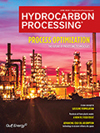April 2024
Special Focus: Maintenance and Reliability
Hot or not: The future of thermal management
Effective and efficient insulation solutions remain paramount for the chemical process, oil and gas, and petrochemical sectors.

 COPYING AND DISTRIBUTING ARE PROHIBITED WITHOUT PERMISSION OF THE PUBLISHER
COPYING AND DISTRIBUTING ARE PROHIBITED WITHOUT PERMISSION OF THE PUBLISHER
Effective and efficient insulation solutions remain paramount for the chemical process, oil and gas, and petrochemical sectors.

Comments